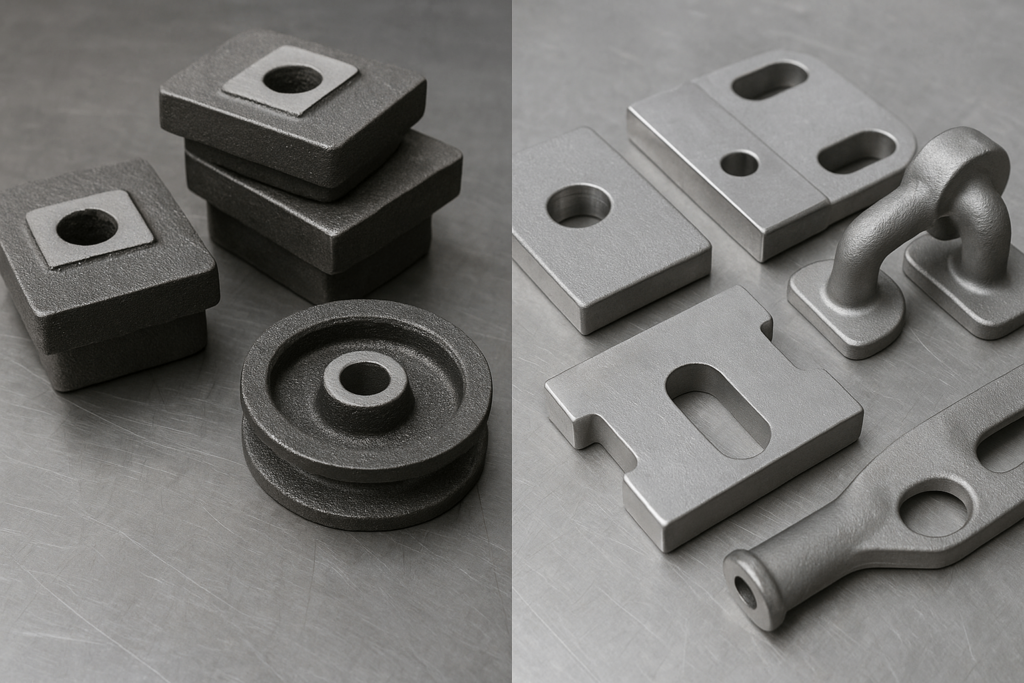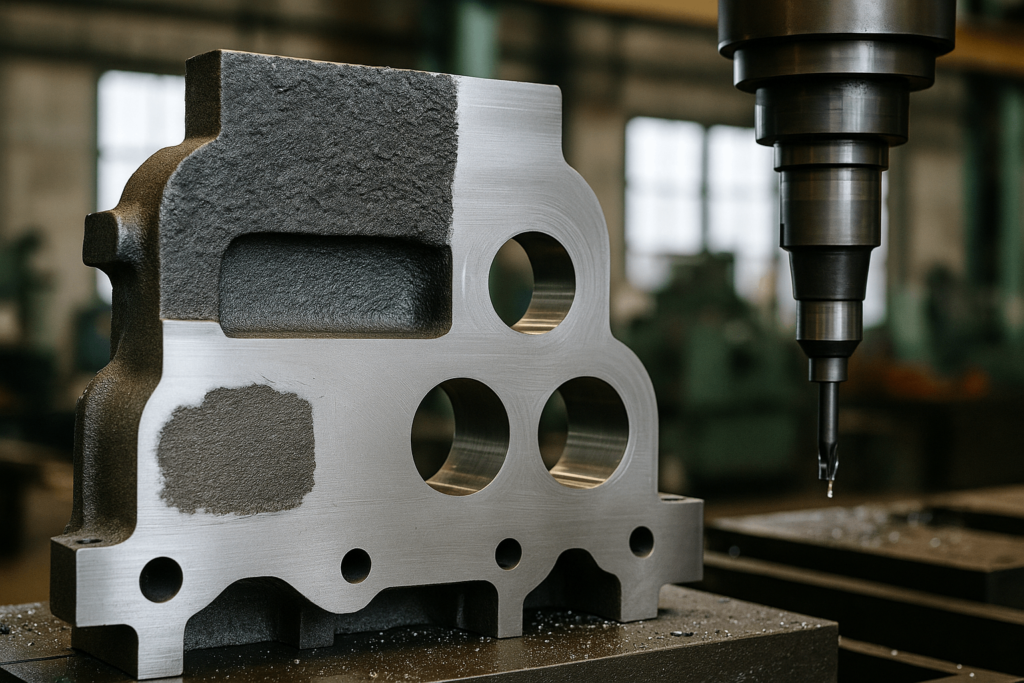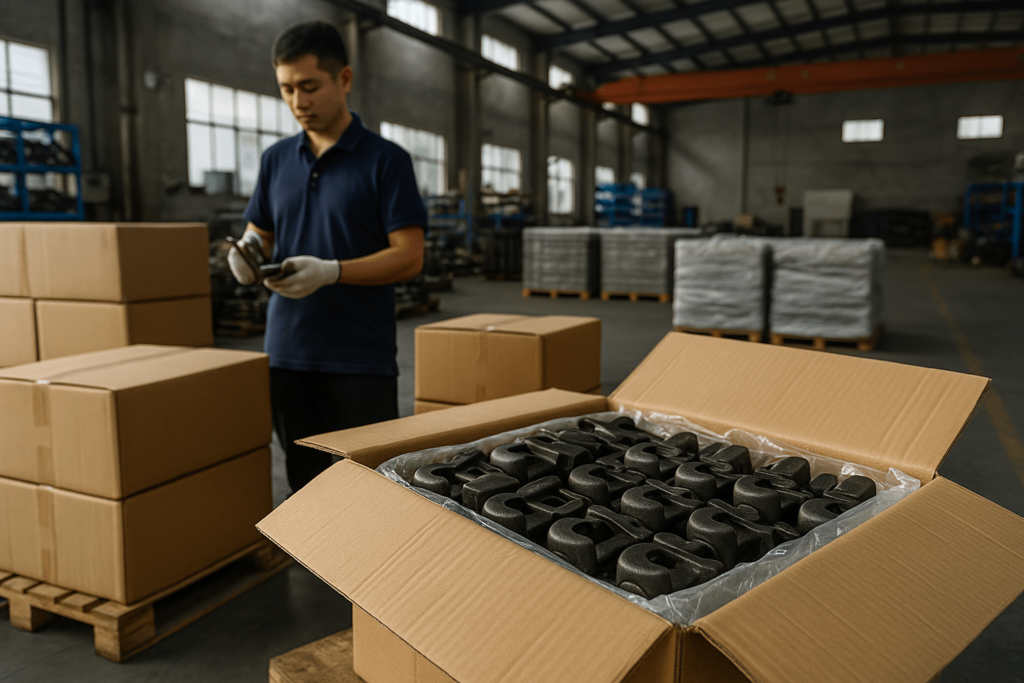Introduction
When sourcing industrial metal components at scale, one decision can influence the entire supply chain: the choice of material. Whether you’re supplying to the construction sector, manufacturing hydraulic systems, or producing structural assemblies for the energy industry, choosing between cast iron and cast steel isn’t a technical afterthought—it’s a commercial priority.
This guide helps procurement managers and wholesale buyers navigate this choice through the lens of sourcing: performance requirements, fabrication compatibility, total cost of ownership (TCO), logistics considerations, and supplier capability. Based on real-world use cases and industry feedback, it offers a structured framework to ensure your material decisions lead to durable, profitable, and scalable product outcomes.
Quick Compare – Cast Steel vs Cast Iron
Carbon Content: Cast iron >2% vs Cast steel <2%
Tensile Strength: Cast steel higher; Compression & Wear: Cast iron better
Ductility & Impact Resistance: Cast steel superior; Cast iron brittle
Machinability & Castability: Cast iron easier; Cast steel stronger but costlier
Weldability & Repairs: Cast steel welds well; Cast iron risky
Cost: Cast iron lower; Cast steel offers better uptime in dynamic applications
Understanding Cast Iron and Cast Steel in a Sourcing Context
Both materials are ferrous alloys, yet their behavior in the field differs considerably. Cast iron contains 2–4% carbon, often with silicon and trace elements. It forms a microstructure with graphite flakes (gray iron), nodules (ductile iron), or cementite (white iron), giving it excellent compressive strength, vibration damping, and castability. It excels in static, thermally stable roles.
Cast steel, with less than 2% carbon, is alloyed with manganese, chromium, or nickel to enhance tensile strength, ductility, and fatigue resistance. It has a more homogeneous structure, making it well-suited to dynamic, high-impact, or load-bearing components.
For procurement professionals, this difference isn’t academic. It defines downstream costs: from tooling compatibility and field failure rates to the number of SKUs needed to service repairs. Based on feedback from over 20+ OEM buyers we’ve worked with, this choice is often the hinge between recurring issues and long-term stability.
Material Performance: Making the Right Match for End-Use Conditions
| Feature | Cast Iron | Cast Steel |
|---|---|---|
| Carbon Content | >2% | <2% |
| Tensile Strength | Low | High |
| Compression Strength | High | Moderate |
| Ductility | Low | High |
| Machinability | Good | Moderate |
| Weldability | Poor | Good |
| Castability | Excellent | Moderate |
| Cost | Lower | Higher |
Tensile vs Compressive Loads
Cast steel outperforms under tension, bending, or impact, which is common in mining equipment, construction machinery, and mobile platforms. Cast iron thrives under compressive load and offers better damping—ideal for machine bases and static infrastructure components.
For example, a YISHANG client in South America replaced cast iron torque arms with cast steel in a conveyor system after repeated cracking. While the unit cost increased by 22%, field replacements dropped to zero over three years.
In addition, another North American distributor faced high return rates due to cast iron valve bodies cracking during sea transport. After switching to low-alloy cast steel, their transit-related defect rate dropped by 42% over two shipping seasons.
Thermal Behavior and Environmental Resistance
Gray iron holds and distributes heat evenly, making it ideal for engines or enclosed housings. However, in environments with rapid temperature shifts, cast steel resists thermal shock better.
In corrosive conditions (marine, chemical), cast iron forms a passive oxide layer, but cast steel—when alloyed or coated—offers better long-term protection, especially for pressure-bearing parts. For regulated environments, cast steel compliant with ASTM A216 or EN 10213 standards is often required.
Machinability and Fabrication: Post-Casting Workflow Efficiency
In volume manufacturing, downstream operations often exceed casting in cost. Cast steel is easier to weld, drill, and surface finish. If your parts require machining or field retrofitting, cast steel reduces tool wear and labor.
On the other hand, cast iron machines well (especially gray iron), but welding is risky and brittle zones around heat-affected areas can compromise structural integrity. Therefore, if a client requires post-sale modification or on-site welding, cast steel is the safer and more flexible choice.
Procurement teams working on low-volume custom orders or high-mix low-volume (HMLV) models benefit from cast steel’s adaptability. Conversely, for standard, unmodified assemblies, cast iron keeps costs down without trade-offs.
Procurement Scenarios: When to Choose Each Material
Key Indicators Buyers Use
Impact resistance and fatigue tolerance for mobile equipment.
Ease of repair and serviceability in remote or offshore sites.
Transportation durability in intermodal shipping.
Lifecycle cost: replacement frequency, warranty claims, and client downtime.
Cast Iron Procurement Fits
Water & Sanitation Hardware: Manhole covers, pipe junctions, drain grates. Requires strength, not flexibility.
Machinery Beds and Casings: Where weight and vibration damping prevent component fatigue.
Stationary Valves & Pumps: Components that operate under constant pressure but minimal movement.
Thanks to its excellent flow characteristics, cast iron is a smart choice for buyers needing intricate geometries at lower tooling stress, especially when lead times and costs are tight.
Cast Steel Procurement Fits
Mobile Equipment Components: Brackets, hooks, armatures in cranes, trailers, and loaders.
Load-bearing Frames: Industrial enclosures, structural reinforcements, pressure vessel supports.
Critical Fatigue Zones: Anywhere flex, impact, or repeated stress defines performance longevity.
Cast steel offers fewer hidden costs over time—especially when failure in operation leads to warranty claims, downtime, or client dissatisfaction.
Beyond Unit Cost: Total Cost of Ownership (TCO) in Real Numbers
Procurement isn’t just about price per kg. Long-term success comes from analyzing:
Failure frequency: A $3 cheaper part that fails twice per year is more expensive than a $4 part that lasts 3 years.
Repair scenarios: Cast steel can be welded and refinished; cast iron requires full replacement.
Maintenance access: Remote sites benefit from parts that tolerate on-site fixes (e.g. mining shafts, offshore rigs).
For instance, one North American buyer of mechanical couplings switched to cast steel, which added 17% to raw material costs. However, field data showed a 39% drop in total replacement costs and 21% fewer service calls within 18 months.
This is where smart sourcing shifts from procurement to profit engineering.
Real-World Application Snapshots
Mining conveyors in South America: Switching from cast iron to cast steel torque arms reduced cracking incidents to zero within three years.
Valve bodies in marine shipping: Cast steel replacements cut defect rates during sea transport by 42%.
North American mechanical couplings: Cast steel raised raw material costs by 17%, but total replacement costs fell by 39% in 18 months.
Production and Manufacturing Considerations
Mold Complexity and Tolerance
Cast iron has superior fluidity, producing sharper corners and thinner sections with lower risk of cold shuts or misruns. As a result, it supports complex housing designs or thin-walled enclosures at scale.
By contrast, cast steel requires precise gating systems and temperature control. Poorly managed pours can create shrinkage cavities. Fortunately, partnering with experienced suppliers mitigates this risk through controlled cooling and post-cast treatment.
Batch Stability and Quality Control
Ask suppliers for data on defect rates, especially in high-volume orders. While cast steel foundries may need higher inspection frequency, cast iron lines often have better predictability in repeat batches.
In either case, your supplier’s QA process matters more than the material itself. Simply put, consistency = predictability = trust.
Logistics, MOQ, and Inventory Planning
Cast steel’s durability makes it better suited for export-heavy supply chains, especially where components travel via intermodal freight. It withstands stacking, impact, and extended warehouse handling.
In contrast, cast iron is more brittle and needs reinforced packaging. Therefore, for large assemblies or sensitive parts, factor in cushioning and potential transit loss rates.
From a MOQ (Minimum Order Quantity) perspective, cast iron is more mold-compatible and cost-efficient in small to mid-batch runs. On the other hand, cast steel molds require higher tooling investment but offer longer lifecycle and repeatability.
Supplier Evaluation: Key Questions for Buyers
Choosing the right metal is half the battle. The other half is selecting a supplier who can deliver quality at scale.
Ask:
Do they produce both materials in-house?
Are they ISO 9001 certified and RoHS compliant?
Can they support rapid prototyping and low-volume trials?
Do they provide process visibility: mold design reports, defect logs, heat treatment parameters?
Do they offer post-casting services like CNC, powder coating, or surface hardening?
YISHANG has successfully delivered over 100,000+ cast components annually to clients in construction, automotive, and energy sectors. We support global wholesale buyers with end-to-end casting, machining, assembly, and export-ready logistics—removing guesswork from complex sourcing programs.
Common Pitfalls: Where Buyers Often Miscalculate
Assuming upfront cost equals best value: Overlooking lifecycle costs leads to higher per-use spend.
Ignoring downstream requirements: Welding, machining, or serviceability may disqualify cast iron.
Underestimating shipping stress: Brittle parts suffer in long-distance logistics if packaging isn’t reinforced.
Relying on suppliers who can’t process both materials: It increases coordination time and risk when switching materials.
Clearly, prevention lies in scenario-based planning. A material choice is only as good as the context it’s applied to.
Quick Identification Tips
Hammer test: Cast steel rings with a clear tone; cast iron gives a dull thud.
Fracture check: Cast iron breaks with a grainy, gray surface; cast steel shows fibrous texture.
Spark test: Cast steel sparks longer and more branched; cast iron sparks are shorter and red.
Summary: Make the Material Work for the Supply Chain
Cast iron offers cost efficiency, superior moldability, and stability under compression. Meanwhile, cast steel delivers strength, adaptability, and lower failure rates under load or motion.
In real sourcing, there is no universal winner. There is only alignment: aligning the material, the application, the supply chain, and the partner.
At YISHANG, we help procurement teams across 50+ countries simplify that alignment. We don’t just provide parts—we provide sourcing clarity.
Have a drawing or specification ready? Send it to YISHANG for a quick and tailored recommendation.




